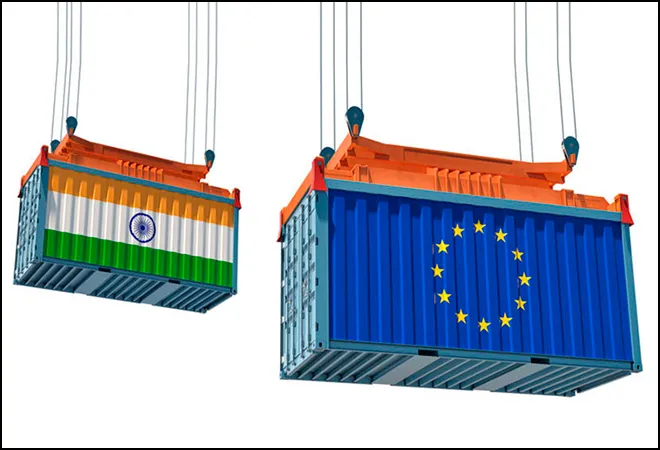-
CENTRES
Progammes & Centres
Location
India's technology partnership with the EU is full of possibilities

The first EU-India Trade and Technology Council (TTC) met on 16 May 2023, closing out a packed week of EU-India engagements, following closely on the tails of the EU Indo-Pacific Ministerial Forum and the 22nd India Trilateral Forum (ITF).
India stands at a critical juncture. With its working-age population set to peak in 2030, it is racing to maximise its demographic dividend by harnessing emerging technologies for sustainable economic growth. New Delhi has recognised the digital economy as a catalyst for this purpose and has emphasised the development of homegrown digital services, electronics manufacturing, and allied services and products. Simultaneously, New Delhi must navigate the peaks and troughs of the ongoing global realignment of partnerships, supply chains, and geopolitics; a phenomenon some scholars have called “gated globalisation”. Therefore, for instance, even as New Delhi may welcome the United States’ (US) strategic hardening and export controls targeting China’s high-tech sectors, India does rely on Chinese imports for its tech sector. In 2021, for instance, 78.9 percent of India's semiconductor device imports were from China, as were 29 percent of its imports of integrated circuits. China is also the world’s largest exporter of lithium-ion batteries, which will power India’s proposed e-mobility revolution. Amidst a global trend towards selective partnerships and trusted alliances, the government and industry alike find themselves grappling with the double-edged sword of supply chain reshoring, nearshoring, and friendshoring.
India's engagement with international partners, like the US, European Union (EU), Japan, and the United Kingdom (UK) among others, will calibrate its approach to tech dependencies. Unlike the US, India cannot afford an all-out “invest, align, and compete” strategy. However, the signing of a memorandum of understanding (MoU) between the two on a Semiconductor Supply Chain and Innovation Partnership, during Secretary of Commerce Raimondo’s visit to New Delhi in March, will aid efforts on both sides to identify opportunities for investment and diversification. The partnership will include a joint effort to map supply chains and seek out areas of complementarity. Importantly, the track record of this partnership will be a precedent for others who are looking keenly at India as a partner. As India explores alternatives, it must consider a sustainable and holistic approach, avoiding the mere substitution of one dependency for another.
The Geological Survey of India discovered 5.9 million tonnes of lithium, but the potential displacement of local communities as well as the environmental damage caused by lithium mining cannot be taken lightly.
Raw materials are another underexplored area ripe for such cooperation. Analysts have proposed reinvigorating India’s state-run rare earths sector in the context of the Quad’s rare earths partnership. Recently, the Geological Survey of India discovered 5.9 million tonnes of lithium, but the potential displacement of local communities as well as the environmental damage caused by lithium mining cannot be taken lightly.
Across the Atlantic, Brussels’ language on de-risking, while remaining vaguely defined, may find more purchase in New Delhi than Washington DC’s approach. The TTC’s three work streams—strategic technologies, digital governance, and connectivity; green and clean energy technologies; and resilient value chains, trade, and investment—are definitely ambitious. Yet the TTC will be an important forum to get the ball rolling, even as negotiations over the EU-India FTA enter a fifth round in a few weeks. The EU and India have agreed to cooperate on resilient value chains, to “work to resolve bilateral market access issues and exchange information on each other's mechanisms on foreign direct investment screening” and “address global and multilateral trade issues, with particular emphasis on the World Trade Organization”. Unsurprisingly, this last stream is the least defined of the three mentioned in the press release, punctuated by officials stating that India plans to challenge the EU’s carbon tax at the WTO a day after the two agreed to “intensify engagement on carbon border arrangements”. However, as the release also highlights, the “largely untapped trade and investment potential” of the relationship means there is plenty of ground that can be covered under the TTC.
The EU and India have agreed to cooperate on resilient value chains, to “work to resolve bilateral market access issues and exchange information on each other's mechanisms on foreign direct investment screening” and “address global and multilateral trade issues, with particular emphasis on the World Trade Organization”.
Towards sharper engagement
In this vein, the EU-India TTC offers a strategic platform to foster a shared understanding of strategic autonomy and de-risking, and the balance between internal measures, such as building indigenous manufacturing capabilities, digital services, and regulatory mechanisms, as well as external ones such as harmonised standards and “third-way” offerings for other partners. As one high-level participant at the 22nd ITF said, strategic autonomy falls on a spectrum, between a kind of maximalist globalisation on one end, and nationalisation and indigenisation on the other. However, there are certain critical sectors that countries cannot hedge on, and the TTC could serve as the space for the EU and India to agree on which sectors they do consider critical and therefore meriting closer scrutiny of supply chains and investment.
With their decisions to bar Chinese vendors from 5G rollouts, Europe and India have agreed de facto that telecom is one such sector. Arguably, financial infrastructure—particularly fintech applications—should be another. Finally, semiconductors, on which the two sides have agreed to coordinate policies, are crucial as well, though not all semiconductors are equal and certain categories, like those used in the automotive sector and defence systems, are more critical than others.
India's technology partnership with the EU teems with possibilities. Notwithstanding the impediments, encompassing persistent disagreements relating to tariffs, labour standards, and carbon taxes that plague FTA negotiations, India and the EU’s growing alignment on strategies to navigate tech dependencies would be well-served and nurtured within the TTC.
Trisha Ray is Deputy Director of the Centre for Security, Strategy and Technology at Observer Research Foundation
The views expressed above belong to the author(s). ORF research and analyses now available on Telegram! Click here to access our curated content — blogs, longforms and interviews.

Trisha Ray is an associate director and resident fellow at the Atlantic Council’s GeoTech Center. Her research interests lie in geopolitical and security trends in ...
Read More +